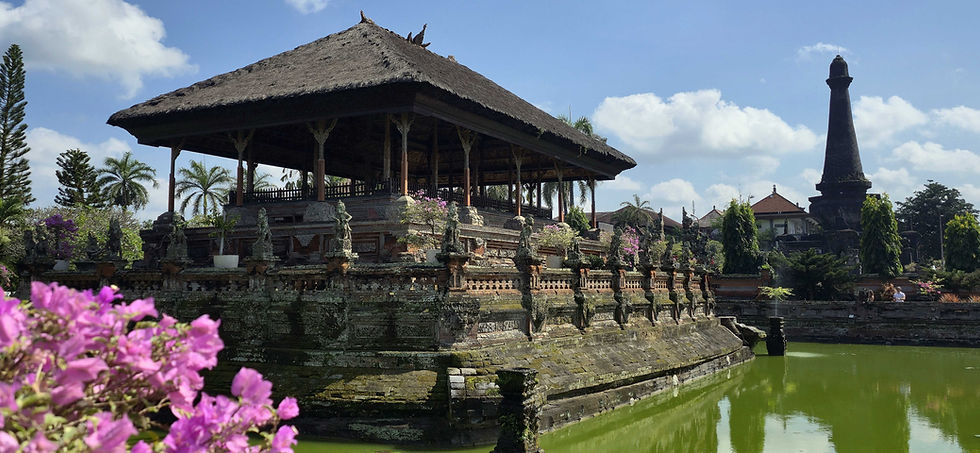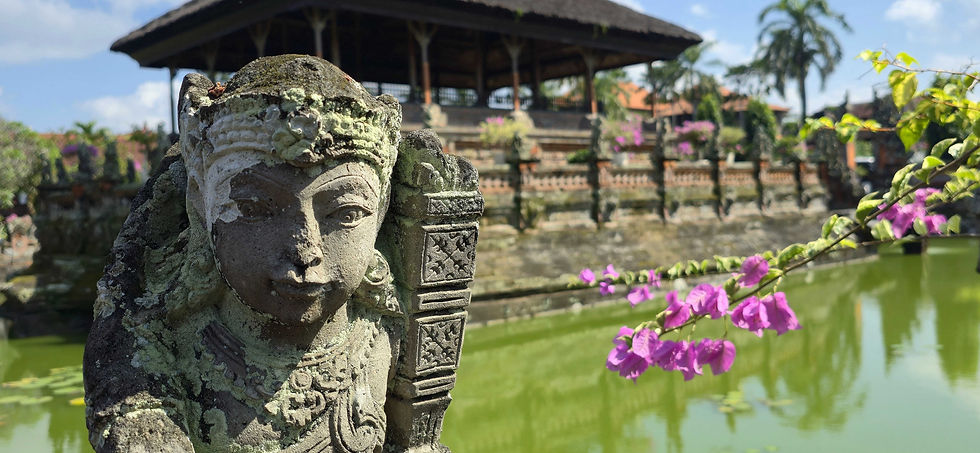Goa Lawah Bat Cave Temple
- Shannon
- Sep 8
- 4 min read
An 11th-Century Temple Guarding the Edge of the Island
Hidden along the southeastern coastline of Bali lies Pura Goa Lawah, one of the island’s most unique spiritual landmarks. Known as the “Bat Cave Temple,” this site is not just a curiosity, it’s one of Bali’s most revered places of worship. The name “Goa Lawah” literally translates to “Cave of the Bats" and true to its name, thousands of fruit bats cling to the cave ceiling above its inner sanctum. While other temples may impress with scale or grandeur, Goa Lawah captivates with its intimacy, its shrines clustered around a cave mouth that hums with natural life.

Founded in the 11th century by the revered sage Mpu Kuturan, Goa Lawah’s historical depth is significant. Mpu Kuturan was one of the earliest priests credited with establishing key elements of Balinese Hinduism, including the concept of the Trihita Karana (the harmony between humans, nature and God) and he established the temple as a sacred site of meditation and protection. In the 16th century, Goa Lawah was reshaped by Danghyang Nirartha, a revered Hindu priest and scholar from Java whose arrival marked a turning point in Balinese spiritual life. Known for weaving deeper philosophical concepts into local practice, Nirartha introduced the idea of moksha, the spiritual liberation from the cycle of rebirth, leaving a lasting imprint on the island’s religious landscape and elevating the temple’s role in the journey toward enlightenment.

Despite its relatively small size, Goa Lawah has stood at the intersection of myth and politics. From the outside, it resembles many of Bali’s ancient temples with its stone gates, tiered meru towers and pavilions for offerings. But its coastal location is not only sacred but strategic. As one of Bali’s Sad Kahyangan Jagad, or “six sanctuaries of the world,” Goa Lawah safeguards the island’s southeastern spiritual axis and plays a vital role in balancing sacred energy across the land. Each of the six temples watches over a cardinal direction and Goa Lawah’s duty is to guard against the chaotic forces believed to surge from the ocean’s depths. During the Dutch invasions around 1849, the temple became entangled in political conflict and served as a stronghold for the Balinese army during the violent Kusamba War, in a failed uprising and mass ritual suicide in protest against colonial rule.
At the heart of Goa Lawah Temple lies its famous cave, a natural chamber that shelters thousands of bats whose presence is deeply revered in Balinese cosmology. These bats are seen as sacred guardians, occupying the liminal space between the visible world and the unseen spiritual realms. Their constant fluttering symbolises the dynamic energy that flows between these dimensions, reinforcing the temple’s role as a spiritual gateway. This connection to both the physical and metaphysical makes the cave a powerful focal point for worship and ritual, embodying the delicate balance between life, death and the mysteries beyond human perception.

Central to the temple’s spiritual significance is the belief that the cave houses Naga Basuki, a mythical serpent dragon who is said to maintain cosmic harmony between the underworld, the earth and the heavens. In Balinese mythology, Naga Basuki represents the life force that sustains and regulates the natural world, a symbol of balance and protection. The temple’s location on Bali’s southeast coast is thought to be part of a larger spiritual axis. According to legend, a secret tunnel connects Goa Lawah to Mount Agung and the Besakih Temple, Bali’s most sacred sites. This unbroken spiritual corridor situates Goa Lawah not just as a coastal shrine but as a vital link in the island’s intricate network of holy places, reinforcing its importance in maintaining Bali’s cosmic order.

The temple’s architecture adheres to the classic Balinese tripartite structure, dividing sacred space into three sections: the outer (jaba pisan), middle (jaba tengah), and inner sanctum (jeroan). Meru towers rise above stone shrines and a bale kulkul drum tower stands near the entrance. Ornate stone carvings and statues are tucked around the cave’s mouth, where worshippers lay offerings beneath the shifting shadows of bats. During major ceremonies, the temple is alive with incense, flower offerings, chanting and the rhythmic sound of gamelan, blurring the lines between the human world and the spiritual realm.
Goa Lawah stands as a testament to Bali’s unique fusion of myth, nature, and devotion. Beyond its striking bat cave and ancient stories, it remains an active place of worship where the island’s spiritual heartbeat can still be felt. Visiting here means stepping into a world where the natural and supernatural coexist in harmony, inviting reflection on the delicate balance that shapes Bali’s identity.

🗺️ Location
Jalan Raya Bayad, Kedisan, Tegallalang, Gianyar Regency, Bali, Indonesia
🚆 How to get there
Getting to Goa Lawah takes time, especially from the busier parts of Bali. From Kuta, the drive is around 2 hours, covering roughly 50km's along the coastal Ida Bagus Mantra Highway. It’s a similar story from Ubud, also about 1 1/2 hours depending on traffic. While the roads are paved and straightforward, congestion around Denpasar and Sanur can add delays. The most reliable way to get there is by hiring a private driver or renting a scooter if you're confident on the road. Rideshare apps like Grab may be available for the trip out but getting a return ride can be unreliable. If you’re already exploring East Bali, places like Tenganan village, Tirta Gangga or Bias Tugel Beach, then Goa Lawah makes a worthwhile cultural detour, as it is on the way.
⭐ Attraction Info
Visitors are welcome daily between 8am - 6pm. Entry is IDR 30,000 for adults and sarongs and sashes are usually included with your ticket. Modest dress is enforced and it’s best to avoid visiting during large ceremonies unless invited. Mornings are quietest, while sunset offers the chance to witness thousands of bats flying out over the sea. Photography is allowed but should be done respectfully, as this is still an active place of worship, not just a tourist site.

Thanks for reading about Goa Lawah Bat Cave Temple - Check out more awesome destinations here!




















